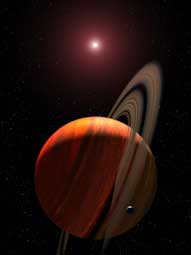 |
|
|
Greek Discovers Invisible Ring Around Saturn |
|
|
In the Dec. 13 issue of the journal Nature, Krimigis' team describes how Saturn's ring current changes over time; it's a dynamic system, doughnut shaped but sometimes appearing like someone took a bite out of it. They also found that Saturn's ring current is persistently asymmetric - unlike Earth's - and it rotates closely in-step with Saturn itself. |
 |
|
"We might get a more intense reading when a solar wind pressure spike passes by," says Dr. Donald Mitchell, a MIMI co-investigator from APL. "But the surprise is that Saturn's ring current didn't become symmetric or dissipate as it does at Earth. It stayed lumpy and rotated around the planet several times. We don't know exactly why that happens, but we have seen it exhibit this behavior repeatedly." |
|
|
(Posting date 6 March 2008) HCS encourages readers to view other articles and releases in our permanent, extensive archives at the URL http://www.helleniccomserve.com/contents.html. |
|
|
|
|
2000 © Hellenic Communication Service, L.L.C. All Rights Reserved.
http://www.HellenicComServe.com |
|
